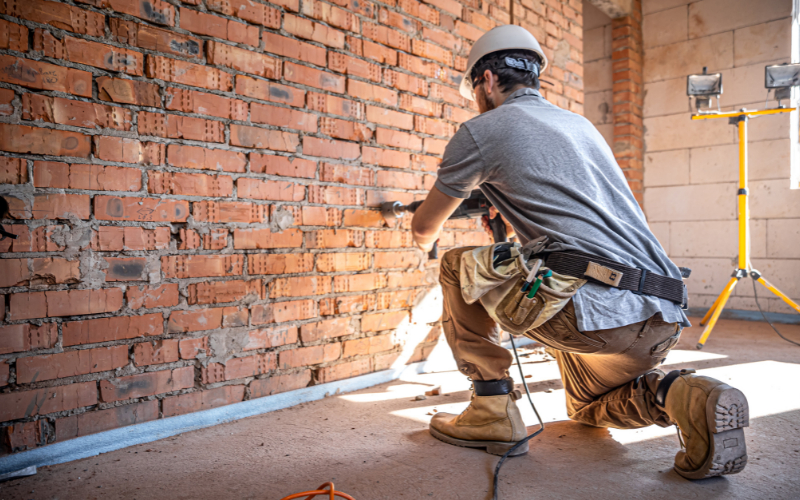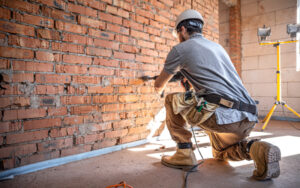
If you are planning a new driveway, patio, or foundation, one of the first questions that comes to mind is: how long does concrete installation take? The truth is, the answer depends on several factors — including project size, weather, and the type of concrete being used. Understanding the full process will help you set the right expectations, avoid mistakes, and ensure your project goes smoothly.
In this guide, we’ll break down everything you need to know about concrete installation — from preparation to curing — in simple terms anyone can understand.
What Is Concrete Installation?
Concrete installation is the process of preparing, pouring, finishing, and curing concrete to form a solid and durable surface. It’s used for sidewalks, driveways, floors, walls, and even large commercial structures.
While the actual pouring of concrete might only take a few hours, the entire installation process — including preparation and curing — can take several days or even weeks to complete.
Step-by-Step Breakdown of the Concrete Installation Process
Let’s take a closer look at the main stages of a typical concrete installation project.
1. Planning and Site Preparation (1–2 days)
Before any concrete is poured, the area must be properly prepared. This step ensures the surface is level, stable, and ready to support the concrete.
What Happens:
-
The site is cleared of grass, rocks, and debris.
-
The ground is leveled using tools like shovels and compactors.
-
Wooden or metal forms are placed to shape the concrete area.
-
Gravel or crushed stone may be added as a base layer for drainage and stability.
Why It Matters:
Proper preparation prevents future cracks and uneven surfaces. Skipping this step or rushing through it can cause the concrete to fail prematurely.
2. Mixing and Pouring the Concrete (1 day)
Once the site is ready, it’s time to mix and pour the concrete. This is usually done in one day — sometimes just a few hours — depending on the project’s size.
What Happens:
-
The concrete is mixed using a ready-mix truck or an on-site mixer.
-
Workers pour the mix into the prepared forms.
-
The surface is spread evenly using tools like rakes and screeds.
Why It Matters:
Even distribution helps the concrete set evenly and prevents weak spots. Timing is critical — concrete begins to harden as soon as it’s mixed, so efficient work is essential.
3. Finishing the Surface (2–4 hours)
After the concrete is poured, it needs to be finished. This step gives it a smooth or textured surface, depending on the design.
What Happens:
-
Workers use floats and trowels to level and smooth the surface.
-
Decorative finishes or textures can be added.
-
Control joints are cut to prevent cracks during curing.
Why It Matters:
Finishing gives the concrete its final appearance and strength. Rushing this stage can lead to poor results and visible imperfections.
4. Initial Curing and Drying (24–48 hours)
Once the concrete has been poured and finished, it begins to set. During this time, it hardens enough to handle light foot traffic — but it’s not fully cured yet.
What Happens:
-
The surface is kept moist using plastic sheets or water spray.
-
The temperature is monitored to ensure even drying.
Why It Matters:
If concrete dries too quickly, it can crack or lose strength. Proper curing helps maintain durability and structural integrity.
5. Full Curing Process (7–28 days)
Concrete continues to cure long after it looks dry on the surface. The curing process allows it to reach its full strength — typically about 70% after 7 days and 100% after 28 days.
What Happens:
-
The concrete’s internal moisture slowly evaporates.
-
Chemical reactions (hydration) continue within the mix.
Why It Matters:
Allowing the full curing period ensures your concrete will last for decades. Cutting corners here can lead to cracks, weakness, or early failure.
Typical Concrete Installation Timelines by Project Type
Different projects take different amounts of time. Here’s a general idea:
| Project Type | Installation Time | Curing Time | Ready For Use |
|---|---|---|---|
| Driveway | 1–2 days | 7–10 days | After 7 days (light use) |
| Patio | 1 day | 7–14 days | After 1 week |
| Foundation Slab | 2–3 days | 28 days | After 28 days |
| Sidewalk | 1 day | 5–7 days | After 5 days |
| Garage Floor | 1–2 days | 7–14 days | After 7 days |
These estimates assume normal weather and proper curing conditions.
What Affects How Long Concrete Installation Takes?
Several factors can impact how long your project will take from start to finish.
1. Weather Conditions
Temperature and humidity play a big role.
-
Hot weather can cause concrete to dry too quickly, leading to cracks.
-
Cold weather slows down the curing process.
Ideally, concrete should be installed between 50°F and 70°F for best results.
2. Project Size
A small sidewalk might be completed in one day, while a large commercial slab could take a week or more. The bigger the job, the more time needed for preparation and finishing.
3. Type of Concrete Mix
Some mixes set faster than others.
-
Standard mix: 24–48 hours to set, 28 days to fully cure.
-
Fast-setting mix: Sets in 20–40 minutes and cures in 3–7 days.
-
High-strength mix: Requires longer curing times for maximum durability.
Your concrete contractor can help you choose the right mix for your timeline.
4. Thickness of the Pour
Thicker slabs take longer to cure because there’s more material holding moisture. For example, a 4-inch driveway will cure faster than an 8-inch foundation.
5. Finishing and Design
Decorative concrete — such as stamped or colored finishes — requires extra steps. Applying patterns, stains, or sealers adds time to the project.
How Long Before You Can Walk or Drive on New Concrete?
Knowing when it’s safe to use your new concrete is essential for avoiding damage.
| Use Type | Time Before Safe Use |
|---|---|
| Foot Traffic | 24–48 hours |
| Light Vehicles | 7 days |
| Heavy Vehicles or Machinery | 28 days |
During the first few days, avoid dragging sharp objects or placing heavy loads on the surface.
Signs That Your Concrete Is Fully Cured
It can be hard to tell when concrete has reached full strength. Here are some indicators:
-
The surface color has lightened evenly.
-
There are no damp or dark patches.
-
It feels cool and solid to the touch.
-
The surface resists scratching or denting.
When in doubt, ask your contractor to test the strength before applying loads or sealers.
Tips for Faster and Stronger Concrete Installation
If you want to speed up your project without cutting corners, these tips can help:
-
Use the right mix.
Quick-setting or high-performance concrete can reduce curing time. -
Plan around the weather.
Avoid pouring during rain or extreme temperatures. -
Keep the surface moist.
Proper hydration prevents cracks and improves strength. -
Work with professionals.
An experienced concrete contractor will manage timing, materials, and curing for the best outcome. -
Seal the surface.
After curing, apply a sealer to protect against moisture and stains.
Why Hiring a Professional Concrete Contractor Matters
Concrete installation might seem straightforward, but it requires technical skill and experience. From mixing ratios to curing schedules, small mistakes can lead to major problems later on.
That’s why hiring a trusted local expert like Concrete Contractors 02816 is so important.
Located at 635 Arnold Rd, Coventry, RI 02816, they specialize in residential and commercial concrete work — including driveways, patios, foundations, and more. Their team handles everything from site prep to finishing, ensuring your project is built to last.
A professional contractor also helps:
-
Avoid premature cracking or uneven surfaces.
-
Ensure correct drainage and slope.
-
Select the right concrete mix for your climate and budget.
-
Handle permits, inspections, and scheduling efficiently.
When it comes to structural durability and long-term value, expertise pays off.
Common Mistakes That Slow Down Concrete Installation
If you want your project to stay on schedule, avoid these common pitfalls:
-
Poor Site Preparation – Skipping proper grading or compaction leads to cracks and uneven surfaces.
-
Incorrect Mix Ratios – Too much or too little water weakens the concrete.
-
Rushing the Curing Process – Using the surface before it’s ready can cause permanent damage.
-
Ignoring Weather Conditions – Pouring during extreme heat or cold can ruin the finish.
-
No Control Joints – Without these, your concrete will likely crack as it expands and contracts.
Maintenance After Installation
Once your concrete is cured, keeping it in good condition is simple but important.
-
Clean regularly: Use mild detergent and water.
-
Seal annually: Protects against moisture, oil, and salt damage.
-
Avoid de-icers in winter: They can erode the surface.
-
Inspect for cracks: Small cracks can be filled before they spread.
Routine care ensures your concrete stays strong and good-looking for decades.
Estimated Timeline Summary
To wrap it up, here’s what a typical residential project looks like:
| Stage | Duration |
|---|---|
| Site preparation | 1–2 days |
| Pouring and finishing | 1 day |
| Initial curing | 1–2 days |
| Full curing | 7–28 days |
| Total project time | About 1–4 weeks |
Keep in mind — this timeline may vary depending on the project size and local weather.
Final Thoughts
Concrete installation isn’t a one-day job. While the pouring might be quick, the full process — from preparation to final curing — usually takes 1 to 4 weeks.
If you want lasting, high-quality results, patience is key. Taking time to prepare the site, choose the right mix, and allow proper curing will pay off for years to come.
For professional guidance and flawless execution, contact Concrete Contractors 02816. Located at 635 Arnold Rd, Coventry, RI 02816, they bring precision, experience, and reliability to every project — ensuring your concrete installation stands the test of time.





